#1 October 1958
Explore tagged Tumblr posts
Text











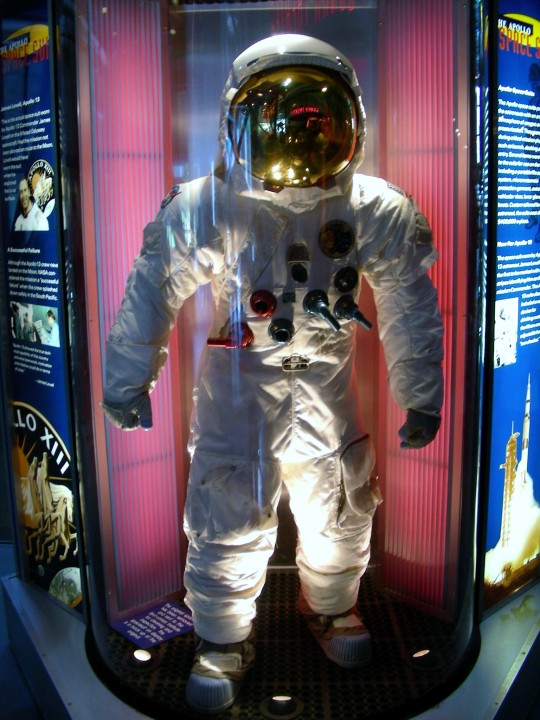








NASA was created to replace NACA on October 1, 1958.
#NASA#created#1 October 1958#anniversary#US history#logo#USA#summer 2009#2010#original photography#Florida#landmark#vacation#travel#tourist attraction#Saturn V moon rocket#interior#exterior#Kennedy Space Center Visitor Complex#Launch Complex 39B (LC-39)#vehicle assembly building#space suit#National Aeronautics and Space Administration#NACA#Apollo 14 Command Module#Launch Complex 39A (LC-39)
238 notes
·
View notes
Text
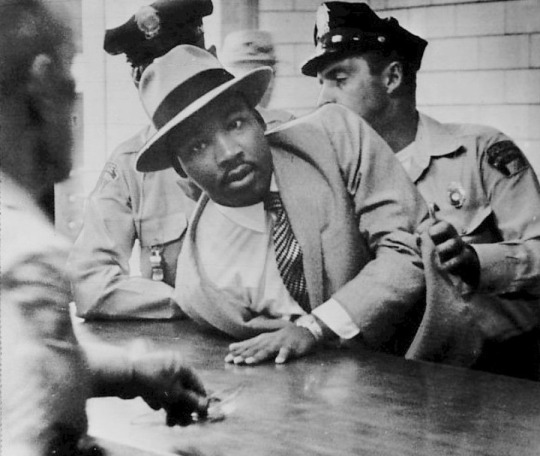
Martin Luther King Jr. was Arrested 29 times for these so-called crimes. Here are just a few occasions when he was arrested and why:
January 26, 1956 — He was arrested in Montgomery, Alabama as part of a "Get Tough" campaign to intimidate the bus boycotters. Four days later, on January 30, his home was bombed.
March 22, 1956 — King, Rosa Parks and more than 100 others were arrested on charges of organizing the Montgomery Bus Boycott in protest of Parks' treatment.
September 3, 1958 — While attempting to attend the arraignment of a man accused of assaulting Abernathy, King is arrested outside Montgomery's Recorder's Court and charged with loitering. He is released a short time later on $100 bond.
September 5, 1958 — King was convicted of disobeying a police order and fined $14. He chooses to spend 14 days in jail, but is soon released when Police Commissioner Clyde Sellers pays his fine.
October 19, 1960 — He was arrested in Atlanta, Georgia during a sit-in while waiting to be served at a restaurant. He was sentenced to four months in jail, but after intervention by then presidential candidate John Kennedy and his brother Robert Kennedy, he was released.
May 4, 1961 — He was arrested in Albany, Georgia for obstructing the sidewalk and parading without a permit.
April 12, 1963 — He and Ralph Abernathy were arrested in Birmingham, Alabama for demonstrating without a permit.
During his time in jail, he he wrote what is now known as his historic "Letter from Birmingham Jail."
June 11, 1964 — He was arrested for protesting for the integration of public accommodations in St. Augustine, Florida.
February 2, 1965 — He was arrested in Selma, Alabama during a voting rights demonstration, but the demonstrations continued leading to demonstrators being beaten at the Pettus Bridge by state highway patrolmen and sheriff's deputies.
Legendary civil rights activist Dr. Martin Luther King Jr. spent a night in the jail on a trespassing charge after he and others were arrested after they attempted to eat in the Monson Restaurant on June 11, 1964. The arrest was reported in The St. Augustine Record and is included in the state legislative committee's investigative report, "Racial & Civil Disorders in St. Augustine," February 1965.
•••
Martin Luther King Jr. fue arrestado 29 veces por estos supuestos “crímenes”. Estas son sólo algunas ocasiones en las que fue arrestado y el por qué:
26 de enero de 1956: Fue arrestado en Montgomery, Alabama, como parte de una campaña "Get Tough (Ponerse Firme)" para intimidar a los boicoteadores de autobuses. Cuatro días después, el 30 de enero, su casa fue bombardeada.
22 de marzo de 1956: King, Rosa Parks y más de 100 personas más fueron arrestados acusados de organizar el boicot a los autobuses de Montgomery. Esto en protesta por el trato que recibió Parks.
3 de septiembre de 1958: Mientras intentaba asistir a la lectura de cargos de un hombre acusado de agredir a Abernathy, King es arrestado frente al Tribunal de Registro de Montgomery y acusado de holgazanería. Poco tiempo después fue liberado, luego de pagar una fianza de 100 dólares.
5 de septiembre de 1958: King fue declarado culpable de desobedecer una orden policial y multado con 14 dólares. Eligió pasar 14 días en la cárcel, pero pronto lo liberan luego de que el comisionado de policía Clyde Sellers pagara la multa.
19 de octubre de 1960: Fue arrestado en Atlanta, Georgia, durante una sentada mientras esperaba que lo atendieran en un restaurante. Fue sentenciado a cuatro meses de cárcel, pero tras la intervención del entonces candidato presidencial John Kennedy y su hermano Robert Kennedy, fue puesto en libertad.
4 de mayo de 1961: Fue arrestado en Albany, Georgia, por obstruir la acera y desfilar sin permiso.
12 de abril de 1963: Él y Ralph Abernathy fueron arrestados en Birmingham, Alabama, por realizar una protesta sin permiso.
Durante su estancia en la cárcel, escribió lo que ahora se conoce como su histórica "Carta desde la cárcel de Birmingham".
11 de junio de 1964: Fue arrestado por protestar por la integración de alojamientos públicos en St. Augustine, Florida.
2 de febrero de 1965: Fue arrestado en Selma, Alabama, durante una protesta por el derecho al voto, pero las protestas continuaron y los protestantes fueron golpeados en el puente Pettus por patrulleros de carreteras estatales y agentes del sheriff.
El legendario activista de derechos civiles, Dr. Martin Luther King Jr., pasó una noche en la cárcel acusado de invasión de propiedad privada después de que él y otros fueran arrestados después de intentar comer en el restaurante Monson el 11 de junio de 1964. El arresto fue informado en el periódico The St. Augustine Record y está incluido en el informe de investigación del comité legislativo estatal, "Desórdenes Civiles y Raciales en St. Augustine", febrero de 1965.
#martin luther king jr#martin luther king day#blacklivesmatter#blacklivesalwaysmatter#blackhistory#history#blackhistorymonth#blackpeoplematter#blackhistoryeveryday#blackhistory365#blackhistoryfacts#black history is everybody's history#black history is world history#black history is american history#historyfacts#black history matters#black history month#black history#knowyourhistory#no justice no peace#historical#justice#share#justice system#english#spanish#read#civil rights#civil rights movement#martin luther king quotes
2K notes
·
View notes
Text
Since I've had some clown in my mentions claiming Nabokovs intent was to present Dolores as equally culpable echoing the good old "but what about her TEEN SEDUCTRESS powers to CONTROL MEN" let's collect some of what Vladimir "Strong Opinions" Nabokov said about the book and Dolly in particular:
"Some simply haven’t read the book or don’t understand it. It is not obscene; it has none of the dirt of many so-called realistic modern novels. “Most critics have failed to stress the pathetic side,” said Mrs. Nabokov. “It’s really a tragic story. Here, in the hands of this maniac is this poor girl—.” “And a very ordinary girl—” Nabokov put in…." (What Hath Lolita Wrought? Ithaca Author Distressed by Some Reactions,” Elmira Telegram, Dec. 14, 1958. )
"In Lolita, who’s the most likable person for you? It’s Lolita. It’s with her that the good reader should become friends. American readers, generally, talk of her as an unbearable kid, but you pity her as you would pity any kid. There’s something touching in her." (“While Lolita Travels Around the World, the Entomologist Nabokov and the Agronomist Robbe-Grillet Exchange Pawns on the Literary Chessboard”), Arts (Paris), October 28–Nov. 3, 1959, 4.)
"She came entirely out of my imagination. Critics, in general, find her odious; I pity her: an orphan, alone in life with a demanding forty-year-old. When I wrote about her last meeting with Humbert, I cried, like Flaubert at the death of Madame Bovary. “She cries every night, and the critics don’t hear her sobs,” said Mrs. Nabokov." (“Nabokov Without Lolita”, Nouvelles littéraires, Oct. 29, 1959, 1–2.)
"But she’s also a very touching character. Toward the end of the book, the reader and the author pity her, this poor child who has been sacrificed on the altar of motels. It’s very sad." (“The Good Mr. Nabokov: Lolita’s Father Forsakes Nymphets for the Sake of Pushkin and Robbe-Grillet”), L’Express, Nov. 5, 1959, 32–33.)
"Is Lolita amoral? On the contrary. It has a very moral moral: don’t harm children. Now, Humbert does [...] And Lolita, isn’t she a victim and not a little slattern….After all, haven’t I indicated the evil of all this, in giving Lolita a stillborn child?" (“Conversation, Vladimir Nabokov: He Likes Humor, Tennis and Proust. He Hates Communists, Sade, Freud”), L’Express, Jan. 26, 1961. )
"How, then, do you explain the “Lolita cult”? How do you explain all these girls who move, act, dress, and talk like Lolita? I wouldn’t know. Perhaps it is a result of the way the popular press has distorted my poor Lo. It has come up with something that has absolutely nothing to do with the book or Lolita the character. Lolita is the story of a sad little girl in a very sad world. The “Lolita cult” is something completely different." (“Love Today: How the Author of Lolita Sees It”), L’Europeo, June 23, 1966, 28–33. )
"Humbert Humbert is a vain and cruel wretch who manages to appear “touching.” That epithet, in its true, tear-iridized sense, can only apply to my poor little girl." (Paris Review, The Art of Fiction No. 40, Issue 41, Summer-Fall 1967)
"Lolita isn’t a perverse young girl. She’s a poor child who has been debauched and whose senses never stir under the caresses of the foul Humbert Humbert, whom she asks once, “how long did [he] think we were going to live in stuffy cabins, doing filthy things together…? [...] It is equally interesting to dwell, as journalists say, on the problem of the inept degradation that the character of the nymphet Lolita, whom I invented in 1955, has undergone in the mind of the broad public. Not only has the perversity of this poor child been grotesquely exaggerated, but her physical appearance, her age, everything has been transformed by the illustrations in foreign publications. Girls of eighteen or more, sidewalk kittens, cheap models, or simple long-legged criminals, are baptized “nymphets” or “Lolitas” in news stories in magazines in Italy, France, Germany, etc.; and the covers of translations, Turkish or Arab, reach the height of ineptitude when they feature a young woman with opulent contours and a blond mane imagined by boobies who have never read my book. In reality Lolita is a little girl of twelve, whereas Humbert Humbert is a mature man, and it’s the abyss between his age and that of the little girl that produces the vacuum, the vertigo, the seduction of mortal danger. Secondly, it’s the imagination of the sad satyr that makes a magic creature of this little American schoolgirl, as banal and normal in her way as the poet manqué Humbert is in his. Outside the maniacal gaze of Humbert there is no nymphet. Lolita the nymphet exists only through the obsession that destroys Humbert. Here’s an essential aspect of a unique book that has been betrayed by a factitious popularity." (“Apostrophes: Bernard Pivot Meets Vladimir Nabokov”), live television interview, Antenne-2 (Paris), May 30, 1975.)
And let's close with my blog title:
"Lolita is an indictment of all the things it expresses. It is a pathetic book dealing with the plight of a child, a very ordinary little girl, caught up by a disgusting and cruel man….But of all my books, I like it the best. " (Author of Lolita Scoffs at Furore over His Novel,” Niagara Falls Gazette, Jan. 11, 1959, 10B.)
Thanks for coming to his TED Talk
#vladimir nabokov#dolores haze#humbert humbert#think write speak#he really could not have made himself clearer#and he deserved a medal for not just biting people at some point
130 notes
·
View notes
Text
me when i'm bored and start deducing ace attorney characters' birthdays from the court record and dates of the cases
*assumes if someone (other than the victim) appears in a case their birthday doesn't happen during that case. birthday ranges are given with as few contradictions as possible
canon birthdays for reference: - dustin prince: september 6th 1987 (murdered on his birthday) - rayfa padma khura'in: december 24th 2013, aka almost christmas (birthdate used to open a safe)
deduced birthday ranges:
phoenix is the only character with a non-canon exact birthdate: october 10 1992. he tells maya he's 24 during 1-3 (oct 16-20 2016) and his profile says he's 33 during the 2026 part of 4-4 (oct 7-9 2026). since he ages 9 years but 4-4 is 10 years after 1-3 the only date possible where this can happen without his birthday happening during the case is october 10. this means he's 23 during 1-1 and 1-2 and 35 during 5-4 and 5-5, despite the court record saying he's 34.
miles has the next shortest range: september 1-4 1992. he's 24 during 1-2 (sep 5-9 2016) and 25 during 2-4 (mar 20-23 2018) so the range is march 24-september 4 1992. to have him in the same school year as phoenix i narrowed it down to the first days of september. this means his age during aa5 and 6-dlc is incorrect.
larry's is pretty easy to find out: he ages 1 year between i1-5 and i2-3 so the range is march 18-april 1 1993. this makes his age during 6-dlc incorrect, though.
iirc aa1 states that dl-6 happens when the above three are in fourth grade (2001), but due to their ages they would be in third grade in the us system.
maya is march 24-june 15 1999. she was 18 during aa2 (jun 16 2017-march 23 2018). this means she is 29 during 6-dlc, not 28, and she could have celebrated her birthday with phoenix in khura'in.
pearl is may 18-jun 15 2009. she was 8 during 2-2 (jun 16-22 2017) and 18 during 6-5 (may 16-17 2028). this means she was 18 during 5-dlc, not 17. also i'm not american but i think schools normally graduate in june over there and 5-dlc was in july, so she should have already graduated senior year by then.
i think ema is the only character from the original trilogy whose age didn't get fucked up after the seven year gap, but the downside is her birthday range spans two years: october 10 2000-february 21 2001. she was 16 during 1-5 (feb 22-25 2017) and 25 during 4-4 (oct 7-9 2026).
ok i know ema says she'll be "turning 16 this year" which implies she's 15 during 1-5 but the court record says she's 16. i went with the court record because it creates less problems and doesn't contradict the fact that she's in junior high.
lightning round for everyone else with deduced birthday ranges in one year! a lot of people's birthday ranges span across two years, so these people age a year less than the timeskip between the years suggest (e.g gumshoe ages 1 year between 2-2 and investigations, despite them being 2 years apart)
manfred von karma: september 11-december 23 1951 (49 during i2-3, 60 during i1-4)
marvin grossberg: april 12-september 4 1952 (61 during 3-1, 64 during aa1)
tyrell badd: september 11-december 23 1958 (42 during i2-3, 53 during i1-4, 60 during i1-5)
samson tangaroa: april 3-december 23 1961 (39 or 57 during i2-3)
winston payne: april 21-august 2 1964 (52 during 1-1, 61 during 4-1)
eddie fender: april 9-december 23 1982 (18 during i2-3, 36 during the rest of aai2)
judy bound: april 3-december 23 1984 (16 or 34 during i2-3)
dick gumshoe: may 4-jun 15 1986 (31 during aa2, 32 during aa3 and investigations)
will powers: april 9-october 15 1993 (23 during 1-3, 25 during i2-5)
lotta hart: march 24-april 4 1994 (23 during aa2, 25 during aai2)
adrian andrews: march 24-october 10 1994 (23 during 2-4, 24 during 3-2)
penny nichols: april 9-october 15 1998 (18 during 1-3, 20 during i2-5)
franziska von karma: april 9-june 15 1999 (18 during 2-2, 19 during aai2)
regina berry: april 9-december 27: april 9-december 27 2001 (16 during 2-3, 17 during aai2)
i2-3 was a bit annoying to work with as you can see lol
for myriam, robin and juniper i narrowed down their birthday range due to the fact that they're in senior year:
juniper woods & robin newman: september 1-october 23 2009
myriam scuttlebutt: january 1-august 31 2010
#long post#maybe i'll do this with tgaa when i've played it#*looks at the technical part of literally every fandom i join* mmm give it to me#ace attorney#phoenix wright#miles edgeworth#larry butz#maya fey#pearl fey#ema skye#rip mia apollo athena trucy simon and nahyuta you should have appeared in both trilogies#ace attorney textpost
61 notes
·
View notes
Text

TV Guide - May 8 - 14, 1965
Robert Osbourne Denver (January 9, 1935 – September 2, 2005) Film and television omedic actor who portrayed Gilligan on the 1964–1967 television series Gilligan’s Island, and beatnik Maynard G. Krebs on the 1959–1963 series The Many Loves of Dobie Gillis.
Denver made his television debut in 1957, playing a small part in one episode of The Silent Service (S01 E37: “The Loss of the Tang”). While teaching at Corpus Christi in 1958, Denver was permitted to audition for a role on the sitcom The Many Loves of Dobie Gillis as a favor to his sister, who was a secretary on the production lot. He got the role and left teaching the following year to become a regular on the series. From 1959 to 1963, he appeared on the series as Maynard G. Krebs, the teenaged beatnik best friend of Dobie Gillis, played by Dwayne Hickman. After filming the first three episodes, Denver received his draft notice, and was briefly written out of the script and replaced, but he was designated 4-F due to an old neck injury and returned to Dobie Gillis having missed only one episode. Denver later reprised his Maynard G. Krebs role in the television sequels Whatever Happened to Dobie Gillis? (1977) and Bring Me the Head of Dobie Gillis (1988).
During his time on Dobie Gillis, Denver appeared on the NBC interview program, Here’s Hollywood. In 1963, Denver played his only major dramatic role on television, as a physician (Dr. Paul Garrett) in one episode of Dr. Kildare, telecast on October 10, 1963; the episode, “If You Can’t Believe the Truth …”, also featured Barbara Eden and Ken Berry. Between the end of Dobie Gillis and the start of Gilligan’s Island, Denver appeared in an episode of The Farmer’s Daughter and in the final episode of The Danny Thomas Show. He also had a one-episode role replacing the actor who played Dudley A. “Dud” Wash, the fiancé of Charlene Darling of the Darlings, on The Andy Griffith Show which was aired March 30, 1964. This was done by the network to promote Denver’s face and make him more familiar to the viewing audience since Gilligan’s Island was about to go on air.
Following the cancellation of Dobie Gillis, Denver landed the title role on the sitcom Gilligan’s Island, which ran for three seasons (1964–67) on CBS, and became a staple of later syndication. His role as the well-meaning but bumbling first mate among a small group of shipwrecked castaways became the one for which he is most remembered. During the run, Denver privately went out of his way to help his co-stars who warmly appreciated his efforts, such as successfully demanding that Russell Johnson and Dawn Wells be included in the series’ opening credits and insisting that Wells get an equal share of the series’ publicity with Tina Louise. A decade after the series was cancelled, Denver played Gilligan in the made-for-TV reunion movies Rescue from Gilligan’s Island (1978), The Castaways on Gilligan’s Island (1979), and The Harlem Globetrotters on Gilligan’s Island (1981). He also lent his voice to the animated series The New Adventures of Gilligan and its sequel Gilligan’s Planet. During the 1980s, he reprised the character of Gilligan for numerous cameo appearances, including episodes of ALF, Meego and Baywatch.
After Gilligan’s Island, Denver went on to star on other TV comedy series, including The Good Guys (1968–1970), Dusty’s Trail (1973-1974) (a show similar to Gilligan’s Island, involving a lost wagon train headed to California), and the Sid and Marty Krofft children’s program Far Out Space Nuts (1975). Four episodes of Dusty’s Trail were later combined to create a feature film, The Wackiest Wagon Train in the West (1976).
Denver’s other television roles included guest appearances on multiple episodes of Love, American Style; The Love Boat; and Fantasy Island. In 1983, he starred in the television pilot The Invisible Woman as the bumbling mad scientist uncle of the title character. (Wikipedia)
Tina Louise (nee Blacker; born February 11, 1934) is an American actress widely known for her role as movie star Ginger Grant in the television situation comedy Gilligan's Island. Louise is the last surviving cast member.
She began her career on stage in the mid-1950s before landing her breakthrough role in 1958 drama film God's Little Acre for which she received the Golden Globe Award for New Star of the Year.
She also had a recurring role on the primetime soap opera Dallas.
In 1962, she guest-starred on the situation comedy The Real McCoys, portraying a country girl from West Virginia in the episode "Grandpa Pygmalion".
In the fall of 1984, she succeeded Jo Ann Pflug as Taylor Chapin on the syndicated soap opera Rituals. (Wikipedia)
47 notes
·
View notes
Text
Sister Imperator #1 - the timeline so far
this is an analysis / summary on key times / events / locations. i put this together because i think it'll be helpful for understanding the lore better.
Sister Imperator's story starts in August 1953. as a child, she lived with her mother, father, and younger twin sisters in Hartford, Connecticut. we don't get any mention of her age, but based on the way she looks, i would guess she was around 10-12 years old at this time.
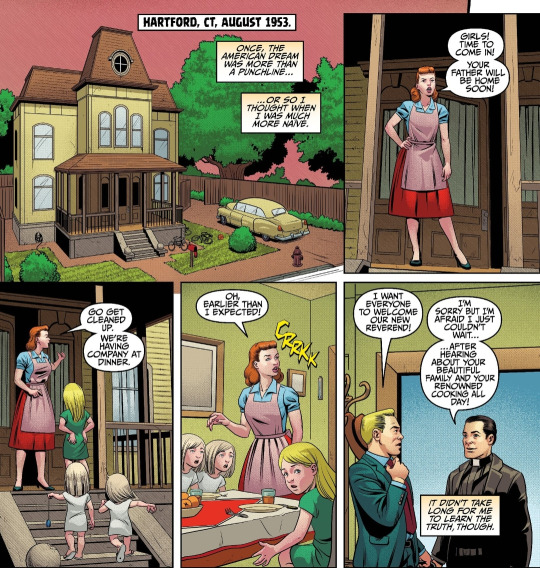

it was at this point in August 1953 that her father was murdered by the Reverend of their church. the Reverend staged the scene to appear like a suicide, and nobody believes Sister when she tries to tell them he was murdered.

after her father's death, there's a timeskip to October 1956. at some point between 1953 and 1956, Sister's mother married the Reverend and he became Sister + the twins' stepfather. Sister was shown watching Elvis Presley's performance on the Ed Sullivan Show on October 28, 1956.

a few days later, Sister Imperator and the twins were attacked by their stepfather on Halloween night (October 31) 1956. again, no explicit confirmation of her age, but she's still pretty young. based on her appearance, and the fact that she was still getting dressed up to go trick-or-treating, i don't think she was any older than 13-15 in 1956.
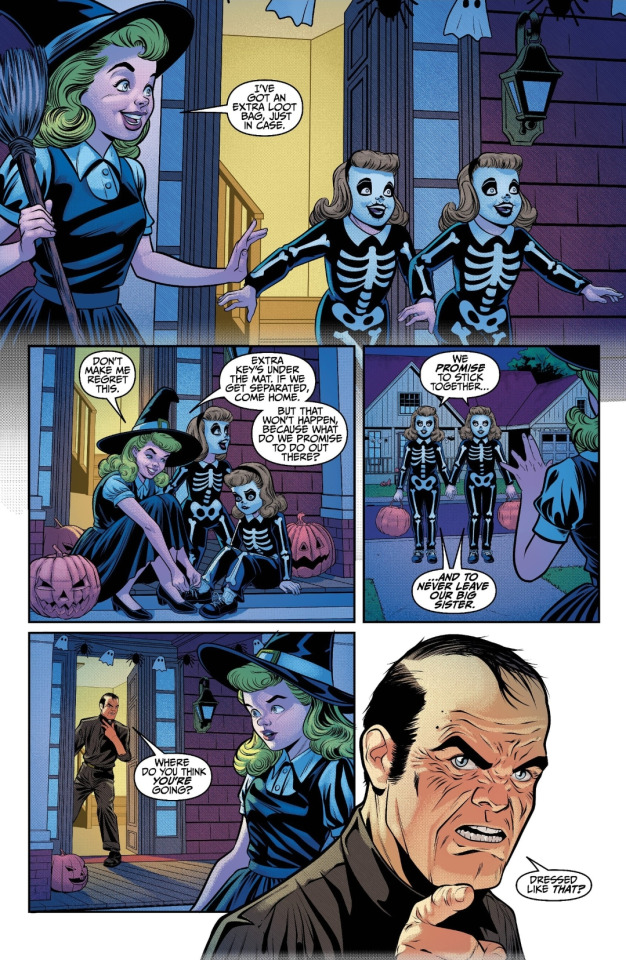
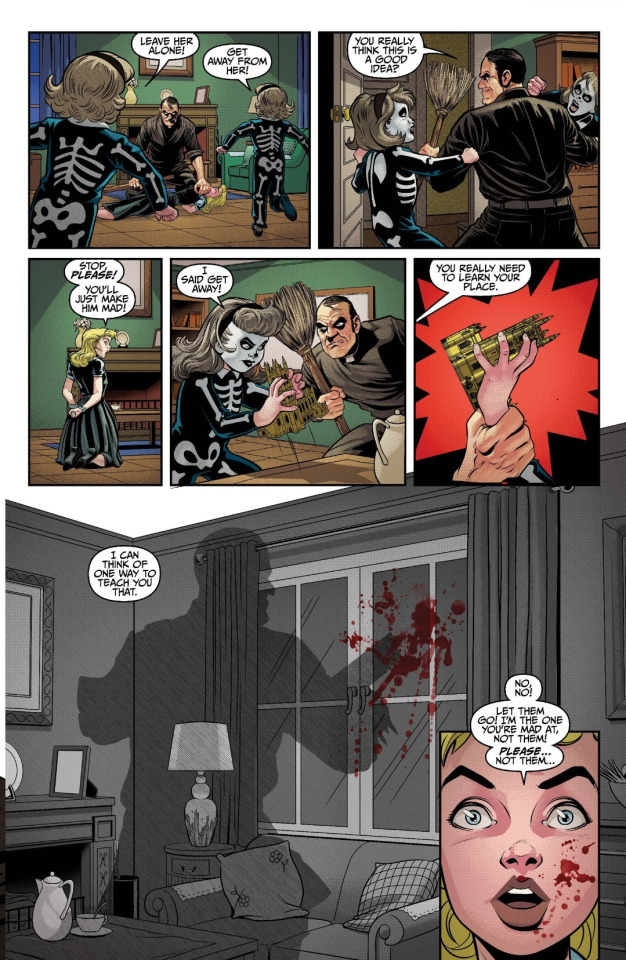
the Reverend blamed Sister for the disappearance / murder of her little sisters. after that, Sister ran away from home at an unspecified time shortly after Halloween 1956.
Sister spent time hitchhiking across the northeastern United States, traveling from Connecticut to New York to Maine.

here is a map showing Hartford, Connecticut; Route 202 in CT; Route 11 in NY; and Route 2 in ME:

during this time, she was homeless. at some point, she became pregnant and was forced to perform an abortion for herself.

after the abortion, she took a Greyhound bus from Maine to Quebec, Canada.
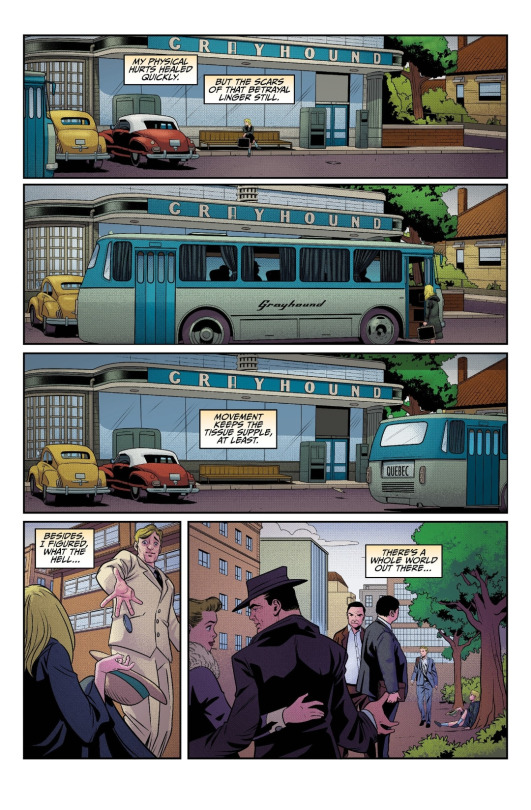
from Quebec, she traveled to Bremerhaven, Germany on the passenger ship Arosa Sun.
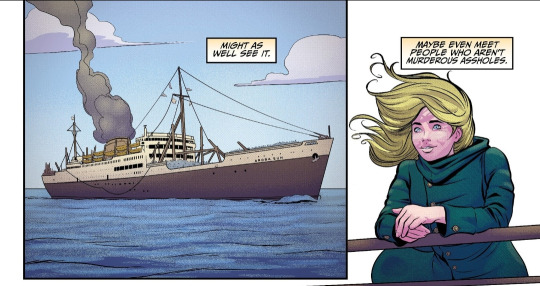

the comic doesn't specify when she traveled from Quebec to Bremerhaven, but the Arosa Sun was a real ship, and i was able to determine a rough timeframe in which she could've traveled based on Canadian Immigration records, blogs, and passenger ship schedules.
the Arosa Sun only sailed its normal route traveling between Bremerhaven and Quebec from August 1955 to September 1958. the crossing took about 10 days one-way, and the ship departed from Bremerhaven / Quebec about once a month. since Sister left home after October 31, 1956 and had enough time to travel to Maine before finding out she was pregnant, i would estimate the earliest she could've left Canada is in spring of 1957, and the latest she could've left Canada is on the ship's last voyage in September 1958.
here's a map roughly showing the distance between Quebec, Canada and Bremerhaven, Germany. note: this is a Google Maps flight path, not the actual sailing route.

to summarize:
August 1953:
Sister's father is murdered by the Reverend.
Sometime between 1953 and 1956:
Sister's mother marries the Reverend.
October 1956:
28 - Sister watches Elvis Presley on the Ed Sullivan show
Halloween / 31 - Sister and her little twin sisters are attacked by the Reverend before they can go trick-or-treating. the Reverend blames Sister for the twins' murder.
Sometime after October 31, 1956:
Sister runs away from home and is homeless for a while, traveling from Connecticut to New York to Maine.
Sister gets pregnant and is forced to perform an abortion for herself.
Sister takes a Greyhound bus from Maine to Quebec, Canada.
Sometime from early 1957 to September 1958:
Sister boards the Arosa Sun and travels from Quebec to Bremerhaven, Germany.
so anyway like. there's no way Sister was even 18 yet when she got to Europe. isn't that all really fucked up.
55 notes
·
View notes
Text
Round One of the Hottest 80s Musician Tournament


Anthony Kiedis
November 1, 1962-
Known as: Vocalist of Red Hot Chili Peppers
Music released in the 80s:
The Red Hot Chili Peppers (1984)
Freaky Styley (1985)
The Uplift Mofo Party Plan (1987)
Mother's Milk (1989)
Propaganda:
Simon Le Bon
October 27, 1958-
Known as: Vocalist of Duran Duran and Arcadia
Music released during the 80s:
With Duran Duran
Duran Duran (1981)
Rio (1982)
Seven and the Ragged Tiger (1983)
Notorious (1986)
Big Thing (1988)
With Arcadia
So Red The Rose (1985)
Propaganda:
#Round 1#anthony kiedis#simon le bon#red hot chili peppers#Duran duran#arcadia#tumblr tournament#the hottest 80s musician tournament#the hottest 80s musician tourney
25 notes
·
View notes
Text
Quote #1
"But He was not only a man. He would have us either worship Him or despise Him—despise Him as a mere man, or worship Him as true God and true man. That is the alternative He presents."
EDIT: This is part of a series of guessing-game style polls that I am doing for the first fourteen days of October.
For the next fourteen days, my queue will spit out a quote from either a Protestant or a Catholic theologian. Responders make their best guess as to which this is.
This is strictly a no-nuance poll. No "They were accused of being a Lollard" this, no "Counter-Reformation" that. Despite the complex theological realities of Late Medieval Western Europe, if they died before 1517, they are being counted as Catholic.

Fulton J. Sheen, Life of Christ, 1958
Fulton J. Sheen was a Catholic bishop, remembered for his radio and television ministry. The above quote was taken from the first chapter of Life of Christ, where Sheen draws upon Lewis's trilemma.
55 notes
·
View notes
Text
Unrolled twitter thread by Progressive International (@ProgIntl)
30 Sept 24 • 4 minute read • Read on X
On 30 September 1965, the Indonesian military, working closely with the US government, initiated a coup that would depose President Sukarno and install the brutal, 30-year dictatorship of General Suharto.

In the dark years that followed, the dictatorship massacred over a million Indonesian communists, with the CIA and US diplomats drawing up “kill lists” for the Indonesian military. The operation would become a template for the US’s regime change operations for decades to come.
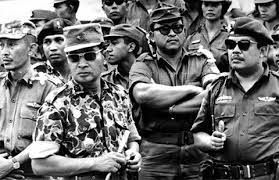
Major-General Suharto with Indonesian Army in 1966
In 1945, President Sukarno led Indonesia to independence from Dutch colonial rule. He championed the Non-Aligned Movement and hosted the historic Bandung Conference, a meeting of Afro-Asian states, in 1955.
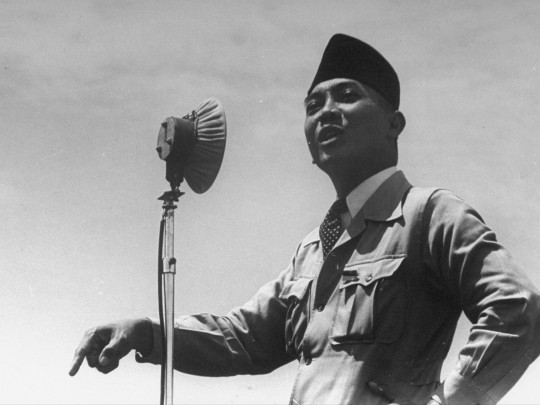
First President of Indonesia Sukarno making a speech circa 1945
Opening the conference and forecasting what was to come, Sukarno said: “We are often told ‘Colonialism is dead’. Let us not be deceived or even soothed by that… Colonialism also has its modern dress, in the form of economic control, intellectual control, actual physical control by a small, but alien community within a nation.”
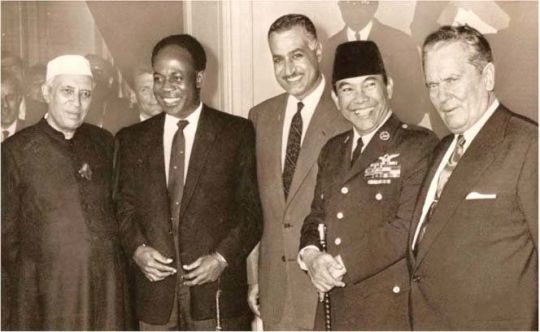
Leaders attending the Bandung Conference 1955 in Bandung, Indonesia. From left: Indian Prime Minister Jawaharlal Nehru, Ghanian Prime Minister Kwame Nkrumah, Egyptian Prime Minister Gamal Abdel Nasser, President Sukarno, and Yugoslavian Prime Minister Josip Broz Tito.
By 1965, Indonesia possessed one of the world's largest communist parties, the PKI. The PKI had a mass membership and mobilized vast numbers of people in the battle against Indonesia’s ruling class.

Campaign of the Indonesian Communist Party (PKI) in September 1955.
Terrified by the strength and organization of Indonesia’s people, the Indonesian military’s 30th September Movement began to purge the PKI.

Men suspected of being IPK members being transported under guard by an armed Indonesian soldier
In the early hours of 1 October, a group of military conscripts murdered six high-ranking generals. Blaming the deaths on the PKI, Suharto used the attacks as a pretext to seize power. CIA communications equipment allowed him to spread false reports around the country and begin a long campaign of anti-communist propaganda.

The US had tried to overthrow Sukarno for years; in 1958, the CIA backed armed regional rebellions against the central government. In 1965, they did all they could to aid Suharto’s murderous power grab.
The campaign soon became genocidal. On islands like Bali, up to 10% of the population was massacred — and luxury hotels soon began to appear over the killing fields.
One US embassy staffer told the US press that Suharto’s military “probably killed a lot of people, and I probably have a lot of blood on my hands, but that's not all bad.”
Time Magazine referred to the killings as “the West’s best news for years in Asia”.

A cable from the US embassy’s first secretary, Mary Vance Trent, to the State Department referred to events in Indonesia as a “fantastic switch which has occurred over 10 short weeks”. It also included an estimate that 100,000 people had been slaughtered.
Cementing his power, Suharto became president in 1967. His ‘New Order’ policy allowed Western capitalism to exploit Indonesia’s cheap labour and plunder its natural resources. Civil rights and dissent were suppressed.
In one of the world’s most populous countries, any possibility for the emergence of a new, democratic political project was eliminated. Richard Nixon described Indonesia as “the greatest prize in Southeast Asia”. Suharto would not leave office until 1998.

U.S. President Ronald Reagan stands with Indonesian President Suharto in the White House South Lawn at the arrival ceremony for Suharto's State Visit. Oct 12, 1982
CIA officers described Suharto’s rise to power and anti-communist purge as the “model operation” and “Jakarta” soon became the codeword for anti-communist extermination programs in Latin America, where hundreds of thousands were massacred in regime change efforts engineered by Washington.
#cold war#us imperialism#american imperialism#western imperialism#indonesia#indonesian history#politicide#indonesian genocide#cia#world history#general suharto#president sukarno#anti imperialism#communist history#decolonization#colonialism#southeast asia#1965 genocide#30 September Movement#balinese genocide#bali#indonesian killing fields#progressive international#knee of huss
73 notes
·
View notes
Text











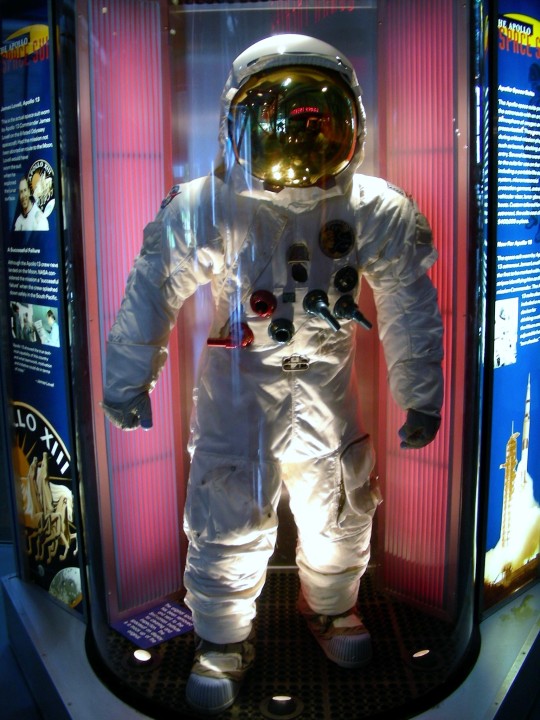








NASA was created to replace NACA on October 1, 1958.
#NASA#created#1 October 1958#anniversary#US history#logo#USA#summer 2009#2010#original photography#Florida#landmark#vacation#travel#tourist attraction#Saturn V moon rocket#interior#exterior#Kennedy Space Center Visitor Complex#Launch Complex 39B (LC-39)#vehicle assembly building#space suit#National Aeronautics and Space Administration#NACA#Apollo 14 Command Module#Launch Complex 39A (LC-39)
6 notes
·
View notes
Text
gifs of 2024 ✨
post your favorite and most popular post from each month this year (it’s okay to skip months)
tagged by @talesfromthecrypts 💜 thanks brittany!
JANUARY
favorite: Paul Newman bday gifset 🥳 (3k) most popular: Zayn Dom (4k), gaygalore: Andrew Miller (19k)
FEBRUARY
favorite: Brain Damage/Possessor parallels 🔫 (793) most popular: Eusebio Poncela and Miguel Molina as Pablo and Juan in Law of Desire (1987) (9.7k)
MARCH
favorite: Dirty Men in Film 👷♂️ (2.7k) most popular: Ken Clark as Stewpot 🍲 in South Pacific (1958) (3.6k), gayarmpits: Archie and Kaleb (8k)
APRIL
favorite: Anthony Perkins as Norman Bates 💙 in Psycho II (1983) (1.2k) most popular: Tryp Bates and Greg Dixxon (11.4k)
MAY
favorite: Bob McCune posing 💪 for "Mr. California" 1949 (3.4k) most popular: Dante Foxx and Rick Hammersmith (6.4k), gaypast: Kyle McKenna and Cole Tucker (8.4k)
JUNE
favorite: violence between gay men in film, or intricate rituals part 1 🤼♂️ (1.9k), also: Christopher Abbott as Kevin in On the Count of Three (2021) (327) most popular: Heath Ledger and Jake Gyllenhaal as Ennis Del Mar and Jack Twist 💚 in Brokeback Mountain (2005) (12.1k)
JULY
favorite: Ryan Gosling loves fisting 🤜 as Colt Seavers in The Fall Guy (2024) (605), and Al Pacino loves piss 💦 as Detective Steve Burns in Cruising (1980) (3k) most popular: Zak Spears (3.5k), gayarmpits: SojMani (37.7k)
AUGUST
favorite: Cary Grant as Leopold Dilg 🔥 in The Talk of the Town (1942) (1.2k), and filmgifs: gay men teasing each other in film, or intricate rituals part 2 🤼♂️ (3.5k) most popular: Sailor T. Rhodes (6.9k), gaygalore: Tony Stefano and Steve Henson (10.3k)
SEPTEMBER
favorite: Psycho/Longlegs parallels (2.2k), and Mike Dytri and Craig Gilmore as Luke 🔫 and Jon in The Living End (1992) (2.1k) most popular: Austin Butler and Tom Hardy as Benny and Johnny in The Bikeriders 🏍️ (2024) (2.8k), hispits: Seven Dixon and Connor Maguire (5.2k)
OCTOBER
favorite: shoeshines in vintage gay media, or intricate rituals part 3 👞 (2.4k) most popular: Brain Damage/American Psycho parallels 🍑 (4.3k)
NOVEMBER
favorite: Christopher Abbott as Reed 🪢 in Piercing (2018) (654) most popular: Randy and Manny (7.7k), hispits: Archie and Sean (8.4k)
DECEMBER
favorite: psychopaths 🖤 (790) most popular: Alan Parker, Joe Leitel and Bruce Reed in Ben-Hurry (1959) (12.4k)
tagging: @acecroft @mikaeled @lindadarnell @normasshearer @stars-bean
@eurodynamic @zanephillips @losthavenmine @rogerdeakinsdp @slayerbuffy
#tag games#my most popular was the Brokeback Mountain gifset until the Ben-Hurry short film gifs i made in december#most popular gifs overall is the SojMani gifset i made for gayarmpits#2024 is the year i became enamored by Christopher Abbott 🥰
31 notes
·
View notes
Text
Another angle of Elvis arriving in Bremerhaven, Germany. October 1, 1958. Some of this is unused footage.
39 notes
·
View notes
Note
do u have any sibling hcs? peter, marlene, mary, emmeline etc
HELLO!!!!
YOU BET I DO!!!!!
i'm going to list off almost all of my sibling hc right now so be prepared!! there's a lot and i won't go into detail but i'm happy to if you wanna ask about any in particular :)
i'll start with the ones you mentioned
Peter Pettigrew (8th August 1960)
1 older sister, Penelope (3rd January 1957) (i may change the name)
Marlene McKinnon (14th September 1959)
3 younger sisters & 1 younger brother, Georgia (5th April 1961) Olivia (11th May 1962) Elizabeth & Thomas (10th August 1964)
Mary MacDonald (10th December 1959)
not sure on the details exactly but i see her as having 2-4 younger brothers and 1 older sister (all muggles)
Emmeline Vance (26th August 1960)
2 younger brothers, Finn (20th June 1961) and Jude (3rd May 1964)
Evan Rosier (13th February 1960)
5 older sisters, Eve (2nd September 1954) Sabrina (6th December 1955) Aimee (29th March 1957) Grace (24th January 1958) and Aria (8th March 1959)
Juliette Wilkes (24th July 1960)
2 older sisters & 2 younger sisters, Jasmine (19th December 1957) Isabella (18th October 1958) Rebecca (19th June 1962) and Victoria (3rd April 1963)
Dorcas Meadowes (15th November 1959)
1 older sister, Dawn (18th July 1955)
(i also hc that Dorcas and Remus are step siblings through their mothers marrying and that Remus has an older brother called Romulus but this goes so against cannon)
Benjy Fenwick (30th May 1959)
1 older sister, Bianca who was killed when she was 10 and Benjy was 8 by death eaters (cba to do the maths and figure out her birthday)
Edgar & Amelia Bones (7th October 1958)
1 older brother, Jamie (3rd March 1952)
Frank Longbottom ( 21st June 1959)
Sooooooo many brothers that nobody actually knows the official count of them. Frank is near the youngest
Hestia Jones (20th March 1960)
1 younger sister, Gwenog ( 28th February 1961)
(two things to say here: 1. Gwenog is a cannon character who's name is canonically Jones, but we don't know if or how she's related to Hestia. Also I've bumped up her age because I wanted her to be more included in the era)
Edmund Avery Jr (7th February 1960)
I'm thinking 1 older sister and 1 younger sister, don't know the details yet
Olivia Gleaves (23rd June 1960)
1 younger brother, Toby (31st May 1961) (we know they were related but we don't know how)
Iola Hillicker (4th May 1960)
1 younger sister, Tamsin (2nd July 1963) (same with Olivia and Toby, we know they're related but not how)
i thinkkkkk that's everyone for now, if you would like me to elaborate please don't hesitate to ask!!! i love writing and reading about siblings more then i probably should tbh
THANK YOU SM FOR THE ASK!!!!
#ace gets asks!!!#the marauders#harry potter#the marauders era#marauders#marlene mckinnon#emmeline vance#evan rosier#peter pettigrew#mary macdonald#hestia jones#gwenog jones#iola hillicker#olivia gleaves#amelia bones#edgar bones#benjy fenwick#frank longbottom#edmund avery jr#juliette wilkes#snapes gang#dorcas meadowes
14 notes
·
View notes
Text
Here’s something I’ve been translating on and off for the past week or so! I was looking at old German youth magazines in order to find interesting articles about classic rock bands (specifically Pink Floyd) and came across this in the 01/1978 issue of BRAVO magazine (One of the most famous teen/young adult magazines in Germany that’s been there since 1958 and is still going strong today!) A lot of youth magazines back in the day had articles and posters about rock bands because, well, that’s the people who were celebrities at that time! This page includes both short descriptions of the band members and a short history of the band up until that point when the issue came out! Enjoy ;)

Here’s the original picture
And here is the translation! (Italized text are context comments added by me to add to the understanding of this text!)
Warning: Some of the information here is obviously incorrect!
Pink Floyd: Their profiles
Nick Mason:
Born on the 27th of January 1945 in London, plays drums, has black hair, brown eyes, is 1,72 m tall (for non metric peeps it’s approximately 5 foot 8), is married to Lindy, has two daughters, owns a vineyard and collects old cars (old timers in German means old/vintage cars)
Rick Wright:
Born on the 28th of July 1945 in London, plays the organ/keyboard, piano, cello, and Moog-synthesizer; has blonde hair, blue eyes, is 1, 74 m tall (approximately 5 foot 9), is married to Juliette, has a son named Jamie, and a daughter named Gaia, loves football (or soccer for American peeps)
Roger Waters:
Born on the 6th of September 1944 in Great Bookham near Cambridge, plays bass, Moog-synthesizer, and sings as well; has blonde hair, grey eyes, is 1,83 m tall (approximately 6 feet), is married to Caroline, and has a 15 month old son named Harry.
David Gilmour:
Born on the 6th of March 1946 in Cambridge, plays lead guitar and sings; has brown hair, blue eyes, is 1,78 m tall (approximately 5 foot 10), is married to Ginger, and has a 2 year old daughter named Alice.
The diary/summary of their career; All their albums
1965
The three architecture students Roger Waters, Rick Wright, and Nick Mason meet and get to know each other, establishing the band Sigma 6.
1966
February: Sigma 6 gets their first fee for a performance in the London Marquee Club and mostly cover popular rock and blues songs. During this time they meet art student Syd Barrett. He writes songs and joins the band as a guitarist and singer. Under his influence Sigma 6 evolve into their own music style: The group does electronic experiments and uses spotlights, reversal film, and recorded footage as part of their stage shows. Thus psychedelic music is born. Syd Barrett is as well (psychedelic), who now comes up with new names for the band almost every month — they call themselves “T-Set,“ “Abdabs” — and in this group a girl sings as well from time to time: Juliette Gale. She later marries keyboardist Rick Wright.
June: The group could pay for a band bus for approximately 200 Mark (the German currency at the time of this article), but decide to separate for the time instead. No one is interested in performing, since the boys want to enjoy the semester holidays as well as after them improve and work harder on their studies; music is fun but a real job is more important. Syd Barrett then has a new idea for a band name: The Pink Floyd Sound. He comes up with his idea through combining the names of two American blues singers: Pink Anderson and Floyd Council. The owner of an artist agency, Peter Jenner, sees a performance from The Pink Floyd Sound in the Marquee, and then from there on decides to manage the band, not knowing the band wanted to break up.
July: Peter Jenner gets the band gigs, and thus Pink Floyd stays together.
October: Pink Floyd are now the stars of the London Underground. They perform in the Roundhouse to 2000 fans, with even Paul McCartney being there to see them.
December: On the 23rd of December the UFO club opens, with Pink Floyd performing there daily henceforth.
1967
January: The English music magazine “Melody Maker” write an article about Pink Floyd, which makes record companies curious about the band. The band accepts the best offer, and as they sign the record label contract, they cash in an advance payment of 40 000 Mark.
February: The first single “Arnold Layne” gets recorded.
March: Arnold Layne goes to the English hit charts.
April: The single is on number 20 in the charts and then falls off. But this beginning success gives them the push they needed to record their first album “The Pipers at the Gates of Dawn.“ Norman “Hurricane” Smith serves as producer for this album, and began his career as a recording engineer for the Beatles. While Pink Floyd work on their album in studio 3 of Abbey Road studios, the Beatles work on their album “Sgt. Pepper’s Lonely Hearts Club Band” at the same time in studio 2; two decade defining groups working next door.
June: Pink Floyd join as a supporting act along with Jimi Hendrix and the Move (runner up band to Electric Light Orchestra) for an England tour, but only get to play 17 minutes.
July: The second single “See Emily Play,“ becomes part of the English hit charts, coming in at number 6, and the first album “The Pipers at the Gates of Dawn” releases.
September: See Emily Play also goes into the German hit charts and reaches number 28. Syd Barrett at this time also creates a speaker system which is still useful today, where the speaker boxes are placed all around the room.
1968
At this time, it is practically impossible for Pink Floyd to continue performing with Syd Barrett. He is more and more off in his own world and mind, often not knowing where he is. Out of necessity, the band thus searches for a second guitarist who could join the band.
February: David Gilmour joins Pink Floyd. Syd is still part of the band, but during concerts his amps are often not even turned on, so that the audience doesn’t know any better about his mistakes.
April: On the 6th of April Syd definitively leaves the band, with manager Peter Jenner going with him. Pink Floyd begin working on their second album “A Saucerful of Secrets.“
June: At a free open air concert on the 29th in the London Hyde Park the band officially announces and debuts David Gilmour as their new lead (and only) guitarist. On the same day the new album releases as well.
1969
July: The soundtrack album Pink Floyd worked on for the film “More,” releases.
October: Pink Floyd have their first concert in Germany on the 11th of October at the Pop and Blues Festival in the Essen Grugahalle venue. On this day, Deep Purple celebrate their first concert in Germany as well.
November: The double album “Ummagumma” releases and makes the group successful worldwide for the first time.
1970
March: The soundtrack album Pink Floyd worked on for the film “Zabriskie Point” releases.
June: Pink Floyd perform the title track of their upcoming new album “Atom Heart Mother” worldwide at open air festivals with recorded footage, dry ice fog, and light bombs as part of their special effects on stage.
October: The album “Atom Heart Mother” releases and leads the album charts in England and America.
1971
The album “Meddle” comes out. This year Pink Floyd is particularly busy; they go from one concert to the next and have multiple tours worldwide.
1972
The soundtrack album Pink Floyd worked on for the film “La Vallée” releases under the title “Obscured by Clouds” as their new album. The rest of the year the band spends inside the studio.
1973
March: The album “Dark Side of the Moon” releases and is on the English and American album charts for over two years, and also goes gold in Germany. It is to this day the band’s most sold album.
October: Pink Floyd perform their last German concert for a long time on the 12th of October at the Olympiahalle in Munich, and it becomes the sensation of the year. Pink Floyd also make their way into the English and German single charts again with the single “Money.”
1974
Pink Floyd are tired of success and go back to their private family lives, with rumors appearing that the group will break up. In autumn, the double album “A nice pair” comes out, which is a rerelease of their first two albums.
1975
September: The album “Wish You Were Here” releases.
1976
This year, Pink Floyd doesn’t appear publicly that much as well, except for some performances at festivals.
1977
January: In Dortmund Pink Floyd start their first German tour since 3 years ago on the 23rd. They have 2 concerts each for Dortmund, Frankfurt, and Berlin, with Munich having 3. All concerts were sold out 2 months before the tour started. Simultaneously the 11th album of the band, “Animals” releases. Even before the album released, “Animals” goes gold, with 250 000 records being preordered. This German tour is also the starting point of a months long worldwide tour — the most comprehensive one that Pink Floyd have undertaken yet.
Written originally by: K. E. Siegfried
Translated from German to English by: me! (Vik)
(Btw my source to where I found this is the Internet archive, love that place!)
also here are some pictures that were included in the magazine of the band!


#Pink Floyd#rock photography#classic rock#60s#60s rock#70s#70s rock#roger waters#david gilmour#nick mason#rick wright#richard wright#syd barrett#rock history#music history#60s music#70s music#translation#magazine article#old magazines
46 notes
·
View notes
Text

TV Guide - February 27 - March 5, 1965
Donna Douglas (born Doris Ione Smith; September 26, 1932 – January 1, 2015) Actress and singer, known for her role as Elly May Clampett on The Beverly Hillbillies (1962–1971). Following her acting career, Douglas became a real-estate agent, gospel singer, inspirational speaker, and author of books for children and adults. (Wikipedia)
Irene Ryan (born Irene Noblitt, Noblett, or Noblette; October 17, 1902 – April 26, 1973) Actress and comedienne who found success in vaudeville, radio, film, television, and Broadway. She is most widely known for her portrayal of Daisy May “Granny” Moses, mother-in-law of Buddy Ebsen’s character Jed Clampett on the long-running TV series The Beverly Hillbillies (1962–1971). She was nominated for Emmy Awards for Outstanding Lead Actress in a Comedy Series in 1963 and 1964 for the role. (Wikipedia)
Nancy Jane Kulp (August 28, 1921 – February 3, 1991) was an American character actor, writer and comedian best known as Miss Jane Hathaway on the CBS television series The Beverly Hillbillies.
In 1955 Kulp joined the cast of The Bob Cummings Show (Love That Bob) with Bob Cummings, portraying pith-helmeted neighborhood bird watcher Pamela Livingstone. In 1956, she appeared as a waitress in the episode "Johnny Bravo" of the ABC/Warner Brothers series Cheyenne, with Clint Walker. Kulp played the role of Anastasia in three episodes of the NBC sitcom It's a Great Life in 1955 and 1956. In 1958, she appeared in Orson Welles' little-known pilot episode "The Fountain of Youth" in the television series Colgate Theatre. In 1960, she appeared as Emma St. John in the episode "Kill with Kindness" of the ABC/WB detective series Bourbon Street Beat, starring Andrew Duggan.
Kulp appeared on I Love Lucy in the 1956 episode "Lucy Meets the Queen", performing as an English maid, who shows Lucy and Ethel how to curtsy properly before Queen Elizabeth. Kulp also appeared in episodes of The Real McCoys, Perry Mason ("The Case of the Prodigal Parent", 1958, and "The Case of the Deadly Toy", 1959), The Jack Benny Program ("Don's 27th Anniversary with Jack"), 87th Precinct ("Killer's Choice"), Pete and Gladys, The Twilight Zone (as Mrs. Gann in "The Fugitive"), and Outlaws ("The Dark Sunrise of Griff Kincaid, Esquire"). Kulp portrayed a slurring-drunk waitress in a scene with James Garner and Jean Willes in the 1959 Maverick episode "Full House". She played a housekeeper in a pilot for The William Bendix Show, which aired as the 1960–1961 season finale of CBS's Mister Ed under the title "Pine Lake Lodge". On the series My Three Sons in 1962, she portrayed a high school math and science teacher in two episodes under different character names, Miss Harris and Miss Fisher. (Wikipedia)
14 notes
·
View notes
Text

Previously available as a Best Buy exclusive, Scream Factory's The Blob Steelbook 4K Ultra HD + Blu-ray will receive a wide release on October 1. The 1988 sci-fi/horror film is a remake of the 1958 classic.
Chuck Russell (A Nightmare on Elm Street 3: Dream Warriors, The Mask) directs from a script he co-wrote with Frank Darabont (The Shawshank Redemption). Kevin Dillon, Shawnee Smith, Donovan Leitch, Jeffrey DeMunn, Candy Clark, and Joe Seneca star.
The Blob has been mastered in 4K and is HDR-10 compatible. Special features are listed below, where you can also see the full Steelbook layout.

Disc 1 - 4K UHD:
Audio commentary with director Chuck Russell, cinematographer Mark Irwin, and special effects artist Tony Gardner, moderated by filmmaker Joe Lynch
Audio commentary with actress Shawnee Smith
Disc 2 - Blu-ray:
Audio commentary with director Chuck Russell, cinematographer Mark Irwin, and special effects artist Tony Gardner, moderated by filmmaker Joe Lynch
Audio commentary with actress Shawnee Smith
Audio commentary with director Chuck Russell, moderated by film producer Ryan Turek
Interview with director Chuck Russell
Interview with actor Jeffrey DeMunn
Interview with actress Candy Clark
Interview with actor Donovan Leitch Jr.
Interview with actor Bill Moseley
Interview with cinematographer Mark Irwin
Interview with special effects artist Tony Gardner
Interview with special effects supervisor Christopher Gilman
Interview with production designer Craig Stearns
Interview with mechanical designer Mark Setrakian
Interview with blob mechanic Peter Abrahamson
Behind-the-scenes footage of Tony Gardner and his special effects team
Theatrical trailers
TV spot
Still gallery

The Blob is back in this horrific tale about a vile, malignant life-form that crashes to Earth in a cozy, rural American town called Arborville. Untroubled by conscience or intellect, the Blob does only one thing – and it does it well. It eats anything and everything that moves: men, women, and children. And tonight it wants to swallow the town of Arborville.
Pre-order The Blob.
#the blob#kevin dillon#shawnee smith#donovan leitch#horror#80s horror#1980s horror#scream factory#dvd#gift#jeffrey demunn#candy clark#chuck russell#frank darabont#80s movies
34 notes
·
View notes